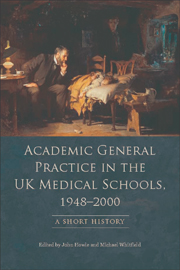Book contents
- Frontmatter
- Contents
- Preface
- Acknowledgements
- Abbreviations
- Timeline
- Introduction
- Dedication
- 1 The University of Aberdeen
- 2 The University of Dundee
- 3 The University of Edinburgh
- 4 The University of Glasgow
- 5 The Cardiff University School of Medicine
- 6 Academic General Practice in Ireland
- 7 The University of Birmingham
- 8 The University of Bristol
- 9 The University of Cambridge
- 10 The University of Exeter
- 11 The University of Leeds
- 12 The University of Leicester
- 13 The University of Liverpool
- 14 The University of Manchester
- 15 The University of Newcastle
- 16 The University of Nottingham
- 17 The University of Oxford
- 18 The University of Sheffield
- 19 The University of Southampton
- 20 The London Medical Schools
- 21 The University of St Andrews
- Appendix 1 Primary Care in the New Medical Schools
- Appendix 2 The SIFT/ACT Negotiations
- Appendix 3 An Overview
- Appendix 4 And Finally…
- Index
11 - The University of Leeds
Published online by Cambridge University Press: 05 August 2013
- Frontmatter
- Contents
- Preface
- Acknowledgements
- Abbreviations
- Timeline
- Introduction
- Dedication
- 1 The University of Aberdeen
- 2 The University of Dundee
- 3 The University of Edinburgh
- 4 The University of Glasgow
- 5 The Cardiff University School of Medicine
- 6 Academic General Practice in Ireland
- 7 The University of Birmingham
- 8 The University of Bristol
- 9 The University of Cambridge
- 10 The University of Exeter
- 11 The University of Leeds
- 12 The University of Leicester
- 13 The University of Liverpool
- 14 The University of Manchester
- 15 The University of Newcastle
- 16 The University of Nottingham
- 17 The University of Oxford
- 18 The University of Sheffield
- 19 The University of Southampton
- 20 The London Medical Schools
- 21 The University of St Andrews
- Appendix 1 Primary Care in the New Medical Schools
- Appendix 2 The SIFT/ACT Negotiations
- Appendix 3 An Overview
- Appendix 4 And Finally…
- Index
Summary
Beginnings
Undergraduate teaching in general practice started life in the University of Leeds on 1 July 1974 as a division within the department of community medicine and general practice. The department was headed by Professor Gerald Richards, whose clear preference was that, in terms of educational and research policy, the new unit should have a considerable measure of autonomy.
Though vigorously supported by the then Dean (Professor Derek Wood), the creation of such a unit was regarded with derision by a few of the influential senior faculty staff. Curricular time was, consequently, limited at first to a fortnight in the students' final year.
Financial issues also loomed large. Some four years earlier the UGC had ruled that NHS fees and allowances earned by practitioners appointed to such a unit should be assigned to the university. There was to be no ‘service increment for teaching’ (SIFT) such as applied to hospital-based teaching units.
Preparation
John Wright was appointed head of the division six months in advance and this enabled the selection of sixteen part-time ‘tutors in general practice’ – local practitioners who would take students regularly into their practices and meet monthly to review problems and progress. This also allowed time to gain experience from visiting other units, both in the UK and in Toronto and at McMaster in Canada.
- Type
- Chapter
- Information
- Academic General Practice in the UK Medical Schools, 1948-2000A Short History, pp. 52 - 57Publisher: Edinburgh University PressPrint publication year: 2011



